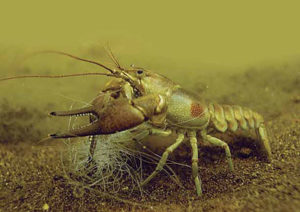Rusty Crayfish
Rusty Crayfish (RC)
Where are RC from and how did they get here?
RC are native to the Ohio River Basin. They are likely spread through non-resident anglers who transport them to use as bait.

How do I identify RC?
You can distinguish a RC from a native crayfish by the rusty red spots on the middle portions of their bodies. Their claws are usually more robust than native crayfish, and have black tips.
Please contact our Water Program Coordinator if you think you have found RC.

Note the RC's rusty side spots and black claw tips
How do RC affect Wisconsin water bodies?
RC are aggressive, and displace native crayfish. They are “clear cutters,” and cut down aquatic vegetation. This decreases habitat for small fish. They also decrease the density and variety of invertebrates.
What can be done once RC enter a water body?
Intensive trapping and harvesting may lower populations of RC in a water body, but it will not completely eliminate the population. The best method of treatment is prevention. Education to anglers, bait dealers, and the general community will help to ensure RC are not spread to additional water bodies.
Additional Resources
Manitowish Waters Lakes Association
Wisconsin DNR Aquatic Invasive Species
Citizen Lake Monitoring Network: Get Involved!
Great Lakes Indian Fish & Wildlife Commission (GLIFWC) Invasive Species Area Maps
US Geological Survey Invasive Species Research
Vilas County Land and Water Conservation Department
Invasive Plants Association of Wisconsin
Books:
Available for loan.
Lake Plants You Should Know- A Visual Field Guide. University of Wisconsin- Extension.
Aquatic Plants of the Upper Midwest- A Photographic Field Guide To Our Underwater Forests.Written by: Paul Skawinski.
Through the Looking Glass- A Field Guide to Aquatic Plants. Written by: Susan Borman, Robert Korth, and Jo Temte.
Saving Our Lakes and Streams. Written by: James A. Brakken.
Your Help Is Needed
Curly leaf pondweed has been found in the Manitowish Waters Chain. Please keep your eyes open and let us know if you see this aquatic invasive plant along your shorelines or docks. Additionally, please check your boats and props to prevent the spread!
Citizen AIS Lake Monitoring
Join a crew to search for suspicious-looking species (plant or animal). Keep your eyes peeled and report any sightings to us.
Clean Boats Clean Waters
Educate boaters at landings and inspect boats and trailers.
Volunteer today, to protect our waters tomorrow.
Email: water@discoverycenter.net
Phone: (715) 543-2085
AIS of the Month
September: Mystery Snails
August: Eurasian Water Milfoil
July: Purple Loosestrife
June: Curly Leaf Pondweed
